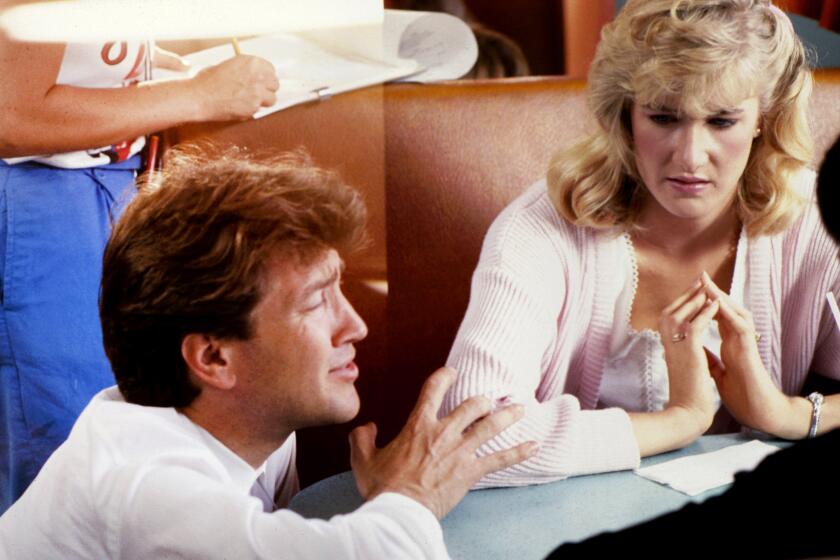Success for a square peg
- Share via
An unlikely duo, quantum physics and spirituality, hook up in “What the Bleep Do We Know?,” a below-the-radar film with a message of personal empowerment.
As solid evidence of its dictum that we create our own reality, the movie has defied the predictions of Hollywood pundits who said there’s no room for such esoterica in today’s crowded, youth-oriented marketplace.
Since its February premiere, the word-of-mouth hit has taken in about $4.4 million, playing to packed houses in California, Oregon, Washington and Arizona. One small measure of its relative success is that it has consistently placed first or second in box-office tallies at the Beverly Center, where it opened in June. Last week, it exceeded the take of all the big-budget studio offerings at the 16-screen complex, except for “Sky Captain and the World of Tomorrow.”
The movie includes interviews with a host of maverick scientific types, as well as a woman who claims to channel the voice of a 35,000-year-old mystic. Among the topics explored: Who are we? What is real? Why are we here? How can neurological processes and perceptual shifts change our behavioral patterns? The dramatic thread follows Marlee Matlin, a frustrated wedding photographer ironing out wrinkles in her uninspired life.
Though not every critic has embraced the unusual blend of talking heads, narrative and animation, the $5-million movie has walked off with film festival awards in Washington, D.C., Houston and Maui. Fans maintain that it helped them overcome a variety of ills -- from drug addiction to insomnia.
“It’s a relief to get out of the 24/7 barrage of negative news and explore the deep connections between mind, body and spirit,” said Jeff Hunter, a 62-year-old Ojai resident who has seen the movie 12 times. “The movie is such an aberration for Hollywood, a world driven by fear and the bottom line.”
Executives at Samuel Goldwyn Films became aware of the phenomenon earlier this year and, along with Roadside Attractions, agreed to distribute the film, which had been peddled by its three directors -- William Arntz, Betsy Chasse and Mark Vicente. Currently in 114 venues, the film will expand to 150 by the end of October before a first-quarter 2005 home video release.
“With over 500 films released annually, 10 new ones each weekend, the staying power of this movie is like nothing I’ve seen or marketed in my more than 20 years in the business,” said Meyer Gottlieb, president of Samuel Goldwyn Films.
With buzz building and much of the release rollout still ahead, he said, the film could defy skeptics: “We expect it will take in $15 [million] or $20 million, possibly even $30 million.”
Such numbers validate the instincts of Arntz, 54, a Buddhist and former research laser physicist who financed the movie with money from the sale of software companies. He made a deal with himself: Half the proceeds from one of the transactions would be devoted to an artistic venture dealing with the realm of the spirit.
Five months after initiating the project in 2001, he brought in Vicente, a former cinematographer (“Sarafina!”) and director (“Where Angels Fear to Tread”). Vicente, in turn, called on Chasse, an independent film producer (“Labor Pains”) who was selling homemade gourmet doggie treats to pay the rent after becoming disillusioned with Hollywood.
Arntz acknowledges that hiring three directors was an oddity in the film world, where a singular vision generally prevails.
“The primary obstacle was our egos -- even spiritual filmmakers have them,” said Arntz, who splits his time between Boulder, Colo., and Tenino, Wash. “When we’d have flareups, we tried to practice what we preached, saying, ‘How do you like those chemicals?’ -- a reference to the movie’s contention that emotions are biochemical and addictive.
Another challenge, he said, was finding a way to present the material “so that the audience doesn’t sit there with its eyebrows furrowed,” he added. “People learn faster after a good laugh.”
Matlin (“Children of a Lesser God”) became involved in the project a month before the shoot, after her agent responded to an online posting of the script. Local talent in Portland, Ore., where the dramatic sequences were shot, had already turned down the role. But it seemed like a good fit: The filmmakers wanted mostly visual footage to counteract the talking heads -- and who was better at non-verbal communication than the hearing-impaired actress?
The filmmakers persuaded their hometown theater in Washington to give them a screen for a week -- a stretch that evolved into seven weeks.
Persuading Hollywood, however, was another matter. After being turned down by a host of potential distributors, Arntz drew on his software experience and drummed up ticket sales through what he called a grass-roots “proof of concept” campaign. The targets: yoga studios; health food stores; and members of Cultural Creatives, an international group devoted to self-actualization, as well as the Unity Church and the Church of Religious Science.
“There were no group sales,” Gottlieb said. “No exhortations from the pulpit. Still, a good-sized percentage of the audience were churchgoers, an underserved market in Hollywood.”
The audience, Arntz said, is now “all over the map, male, female, young, old.” And for those who want to go further down in the “rabbit hole,” as a character in the movie puts it, a four-hour video version with more scientific data is in the works.
For Tony Cooper, a San Francisco small-business consultant, the themes are particularly resonant. The thrust of his practice, he says, also focuses on personal empowerment and visualization.
“If quantum physics is the science of possibility, as they say, this movie is the practice of possibility,” he said. “The filmmakers broke through apparent obstacles and got their message out there with little or no support.”
More to Read
Only good movies
Get the Indie Focus newsletter, Mark Olsen's weekly guide to the world of cinema.
You may occasionally receive promotional content from the Los Angeles Times.










